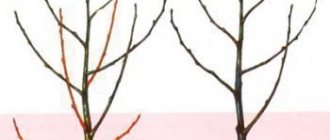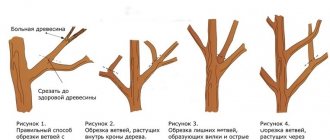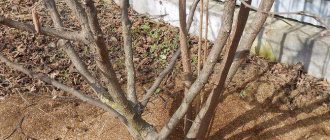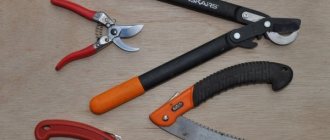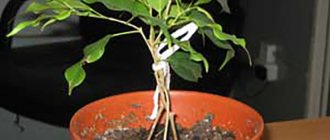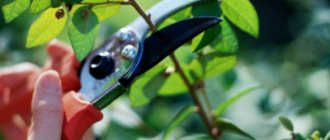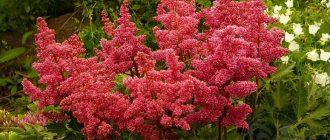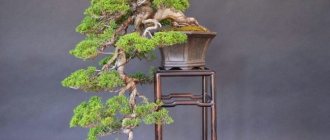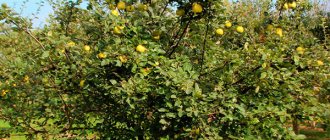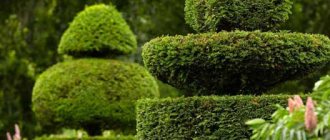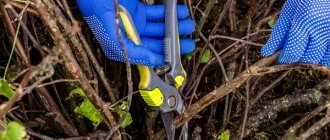Pruning a pine tree is a regular, painstaking, creative procedure. Scots pine is often used to decorate garden or summer cottage plots.
Scots pine pruning is carried out to create objects that decorate the garden plot and ensure sufficient sunlight for other garden plantings. In order for a pine tree to decorate, it needs to be trimmed, rejuvenated, and given an original shape to the crown. These procedures require constant attention, skill and skill.
It is better to form Scots pine after a year has passed from planting the seedling.
Scots pine pruning is carried out for the purpose of:
- rejuvenation. By pruning dead branches, more young branches appear;
- recovery by eliminating obsolete branches that are a source of fungal diseases. To revive a tree, dead shoots are removed;
- protecting others. Heavy shoots break off and cause harm to people and plants;
- creating conditions for other plantings. A plant taller than two meters blocks the light of the sun from other plantings, so it is cut;
- creating an aesthetically attractive plant by decorating the crown and reducing the height of the evergreen representative.
In addition to watering and fertilizing, coniferous plantings are periodically trimmed.
Pine trimming involves:
- eliminating unnecessary branches if the crown is branched. Getting rid of poorly placed shoots that spoil the appearance of a coniferous plant. Thinning of branches is carried out if they are dry, broken, damaged or often located close to each other. The branches found for thinning are removed, leaving a small cut;
- pinching. This method of processing the plant is convenient for creating a dense crown of conifers. Work on crown design is carried out at the very beginning of summer, when the growth of newly emerged shoots or candles is completed. With this type of haircut, the top of the head is cut off with garden tools and shoots appear in its place. Thanks to this, the crown looks lush and takes on the shape of a ball;
- pruning This type of haircut involves trimming part of a pine tree trunk, regardless of its age. This cutting method stops the growth of the plant at a level of two meters. To do this, cut off the branches of the pine tree, starting from the top, and then regularly remove the lateral shoots so that they do not form the top. This will make the prickly representative of the flora more magnificent.
Gardeners understand the need for pruning pine trees, but not everyone knows the correct approach and scheme, as well as the rules by which such pruning is done.
In order for the pine tree to acquire the desired shape and become fluffy, you need to know about the types of pruning and do them following the rules.
The following types of pruning of coniferous representatives are distinguished:
- helping the growth of new branches and needles;
- eliminating substandard branches;
- forming a crown of different shapes;
- including all types of pruning;
- curly processing is done to create splendor, form the crown and stop the growth of the coniferous pet.
To preserve the natural shape of pine, spruce and other coniferous trees, it is enough to prune the plant.
For simple pruning, the height of a coniferous pet should not exceed 180 cm. Decorating the crown of a pine tree will be more difficult if it grows significantly. Regular sanitary procedures, which should not be delayed, will help make the pine fluffy.
Decorative pruning of pine
The formation of Scots pine can be carried out in various ways. Owners of garden plots set up a hedge or grow an exotic tree in the form of a bonsai. Using decorative processing of pine, you can form objects of various shapes from wood.
It is best to start forming a tree in the shape of a ball in May. Pine buds need to be pinched so that shoots form in the right place. It is better to cut mountain pine shoots to 1/2 length. If it is necessary to form a pine tree in the form of a bonsai, then in this case the length of the bud is cut by 2/3 or more. By the end of summer, fresh buds will appear on the pine tree, which will be able to develop next season.
When decoratively pruning coniferous plantings, it is important to decide what height of the tree is expected and, based on this, pinch it. When carrying out decorative pruning, it is important to adhere to measures.
Crown formation
How to form a pine tree without damaging it must be decided by each owner of a summer cottage, choosing the necessary techniques. In this case, it is necessary to take into account the form given by nature, the representative chosen for processing, and what role it will perform.
There are general rules on how to correctly design the crown of conifers:
- It is recommended to start work after a year of planting the plant on the site;
- To shape the crown of coniferous trees, molding pruning is used, which is done after the shoots have finished growing;
- To ensure that the crown is formed correctly, pruning is done regularly.
The crown is formed in one of the most common forms:
- traditional in the shape of a ball, pyramid, cone. This haircut requires special skill;
- hedge, which is obtained by annually trimming the branches and crown. With this pruning, shoots grow from the sides, gradually closing the gaps between the trees;
- nivaki. With such pruning, the crown of a coniferous plant can have different geometric shapes and the position of the trunk. Pruning is carried out annually: the emerging shoots are cut in half, the candles are pinched, and part of the needles are cut off.
Scheme for trimming Niwaki
How to trim
The main task when carrying out work is not to harm the health of the plant. It is important to consider the purpose for which the tree was planted in this area and what shape the crown was originally. This will make the pine neat and give it an unusual shape. This procedure is quite labor-intensive and requires certain knowledge and skills. The first cutting can be done a year after planting, if the plant has taken root and feels good in the garden.
There are several types of pruning:
- Thinning branches allows you to get rid of dry or damaged branches, those that are “wrongly” positioned. You need to make the shortest possible cut. The branch should be deleted completely.
- Pinching (shortening) is a method of forming a spreading crown. In this case, use pruning shears to cut off the entire young shoot or just the tip.
- Trimming is the removal of the top portion of a trunk to control height.
At the preparatory stage it is necessary:
- check and disinfect the instrument;
- prepare varnish in case of damage;
- outline in advance the branches that need to be removed;
- decide on the shape and size for trimming.
Find out how to plant a pine tree in your summer cottage.
It is better to carry out activities on cloudy days, since increased evaporation of moisture in sunny times can cause brown spots to appear on the needles.
Sanitary care for pine
Sanitary pruning is used to eliminate dead and diseased branches. This pruning is done as needed. If dead branches remain on the tree, it can lead to disease. Often branches are damaged by strong winds and rain. To prevent branches from spoiling the tree and creating dangerous situations for others, they must be removed. To improve the health of the tree, it is recommended to remove shoots that are tightly pressed against each other. With this arrangement, the branches are injured and can become a source of disease development.
Wood rejuvenation
Coniferous trees that have been on the site for more than 10 years have many dry and bare branches. Such branches must be removed, which stimulates the growth of new shoots. The purpose of rejuvenating pruning is to prevent the growth of the ends of the shoots, as this leads to the appearance of long shoots not covered with needles.
Rejuvenation is carried out as follows:
- in mid-September the ends of bare old branches are cut off. This circumcision stimulates dormant buds;
- large processes that are not endowed with a growth point are eliminated;
- in early spring, non-viable shoots located in the lower part of the crown are pruned;
- The branches are cut so that the remaining part remains covered with needles, which will prevent them from drying out.
Thanks to rejuvenating measures, new needles and young shoots will appear on the coniferous tree. Pruning for rejuvenation is done after three years.
Best time to get a haircut
Based on the goals of the haircut, choose the optimal period of time. Sanitary pruning, for example from broken branches that interfere with the growth of others or may harm neighboring plants, is carried out regardless of the season.
In the spring, the following goals are pursued:
- stimulation of candle growth;
- crown formation;
- giving a certain appearance.
Video: pruning mountain pine
In summer, it makes sense to remove old branches that excessively thicken the crown, negatively affect the growth and development of the plant, reducing the intensity of the solar flux. Pruning in the fall is aimed primarily at rejuvenating the pine tree. It is necessary to trim the bare ends of old branches on which candles will no longer appear. This will help awaken new buds.
When to do pruning work
Pruning of coniferous trees varies depending on the time of implementation.
| Trimming time | Types of jobs | Expected Result |
| Spring. The appearance of candles before the appearance of needles | Pinching growing shoots. If necessary, the main kidney is removed. Sanitary pruning. | Crown design, appearance adjustment. |
| Summer | Removing non-viable branches, pruning excess shoots from young trees. Sanitary pruning. | Stimulating the growth of fresh shoots. Shoots extending beyond the boundaries of the crown are removed. The cambium released from the pruning site quickly heals wounds. |
| Autumn | Pine tree trimming work is underway. Remove the ends of dead shoots. Rejuvenating haircut. | Tree rejuvenation. |
| Late autumn, winter | No work is being carried out. | The tree is saved from death. |
General rules
Pruning is a procedure consisting of removing branches, pinching the tops and reducing shoots. Periodically trimming the tree is necessary if the pine tree shades neighboring crops, interferes with power lines, or is infested with pests. The process should preserve the plant’s beauty and health.
Pruning is carried out from early February to spring until sap flow begins. If the procedure is carried out in the summer, the cut sites can become a gateway for fungal diseases. Dry branches can be removed at any time, since they do not contain juices. The exception is pinching: it is carried out at the beginning of summer, when the growth of shoots and “candles” has completed.
Related article:
Varieties of juniper with photos
The first pruning is done during planting, removing damaged roots and branches. Young shoots should be cut off when they become large enough to affect the shape of the crown.
Before starting the procedure, it is necessary to identify the parts to be removed. It is better to start working with a young plant, since adults do not tolerate pruning well and get sick. When cutting a branch, you should leave a green shoot next to it, otherwise it will die.
Unlike many other plants, pine does not have a so-called “dead zone”. This means that the tree branches do not die off due to density. But the lower ones can dry out due to lack of light, so they are periodically removed.
Like most conifers, pine has one central trunk. If several of them have formed, leave one, the rest are removed.
Post-procedure care
Caring for a coniferous representative is not particularly difficult. However, when pruning, it is important not to forget that this treatment injures and weakens the coniferous tree, which can cause it to dry out, weaken, and cause the needles to turn yellow. Cutting off branches is traumatic for an evergreen plant. After the pruning procedure, the plant needs to be looked after. If the tree turns out to be sick, then it needs to be fed with mineral or phosphate fertilizers.
You need to pay attention to watering the plant. It shouldn't be too frequent. Usually twice a month is enough. Gardeners who have been growing coniferous trees for a long time, after pruning the plant, strengthen it with stimulants specially created for this purpose.
Features of pinching
It is necessary to pinch pine trees so that after pruning they do not become too lush and spreading. This process is carried out as follows:
- in the left hand the shoot is clamped between the index and thumb;
- then you need to twist the tip of the shoot with your right hand - when the shoot is twisted in this way, the upper bud becomes the leading one, since this process creates an oblique break line;
- unnecessary shoots can be twisted completely.
Pruning without pinching the tree is not enough, since it is due to it that new buds awaken in the spring, the shoots of which are pinched in the same way a year later. But it is very important to ensure that you do not miss the desired areas when pinching, otherwise they will form long branches that disrupt the structure of the crown.
Tools that can help carry out this procedure are pruning shears, as well as a garden saw or hacksaw, which can be used for particularly large branches.
Rules for pruning
In the question of how to trim pine trees, there are certain rules:
- no more than a third of branches, needles, and buds should be removed in one pruning;
- Be sure to remove bare branches when pruning;
- cut the pine to get a spherical shape, better with well-sharpened and cleaned tools;
- there is no need to treat the place where the branches are cut with garden varnish; it is treated with tree resin;
- branches from a coniferous tree should be cut at an angle of 45 degrees. The top edge should be about two millimeters higher than the bottom and no more;
- The length of the cut should be controlled so that the tree does not lose a lot of resin, and it is enough to treat the area where the branches have broken off. Cutting too long will cause unevenness and dehydration of the bacon;
- when cleaning old, thick branches, you need to try not to damage the bark of the pine tree;
- if a large wound is formed on the tree during pruning, it must be treated with garden varnish;
- by cutting the branches very low, you can observe a long healing of the “wound”, the consequence may be the death of the bud or you will get a frail shoot;
- Old, thick lower branches of the ephedra are best cut with a saw, not forgetting to fix the branch as you work.
To properly trim the crown of conifers, you can use the diagram presented in the video, which explains the pruning process for a coniferous plant step by step.
Basic Rules
There are a number of nuances that need to be taken into account in order to correctly form not only a beautiful, but also a healthy pine crown in the garden.
- It is important to work carefully so as not to damage the dormant buds of the tree. Subsequently, it is from them that 3 or 4 strong shoots are formed, giving the crown more splendor and greater roundness.
- Make sure that the tools you use to perform the cutting procedure are clean. Due to contamination, there is a risk of infecting both an adult and a young tree.
- In order not to cause damage to the pine tree, you should cut off about 1/3 of the total mass of branches.
- To prevent harmful bacteria from getting on the cuts and subsequently causing rot, it is important to treat the shortened areas with copper sulfate. Garden pitch is also used for these purposes, especially when it comes to large cuts.
- Do not prune too often, otherwise the tree may weaken and there is a risk of disease.
- Pay special attention to the condition of the lower branches, as these are where you most often see signs of dryness.
- It is permissible to combine pruning of anti-aging and health-improving types in one procedure. However, it is important not to do this procedure in the autumn, otherwise the growth of needles will slow down significantly.
- You should not trim the pine tree by its needles if, after spring pruning, some branches are still growing vigorously. Otherwise, your pine may turn yellow and look unsightly.
- The best pruning tool is garden shears with long, sharp blades.
